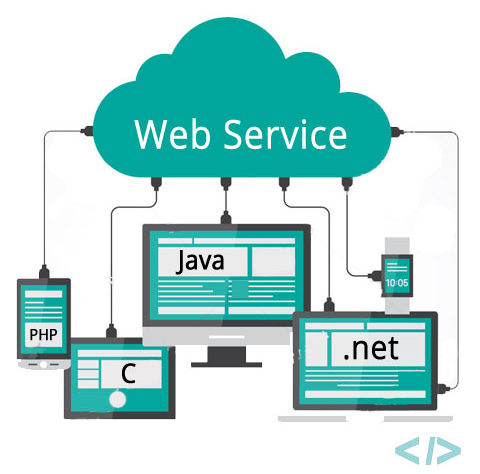- Understanding Web Services
Web Service is a software system designed to support machine-to-machine interaction that can be operated over a network as well as a set of functions, logic, methods as standard data exchange between applications or systems that can be accessed remotely by various devices with a programming language, architecture or a different platform. The structure of the web service can be built using the Simple Object Access Protocol (SOAP) or the REpresentational State Transfer (REST), while the functions are represented in the form of text, JSON or XML format [1], [2], [3]
- Web Technology Development
Web 1.0
the first generation of the website. In this type of visitor can only search and browse (browsing) information data on the web. The world wide web first found its form in November 1990. Until 1993, the internet network was growing so rapidly. Generally, websites are in the format of “online brochures” – websites that convey one-way information – generally in the form of profiles, news portals, online shops, email services, etc. The web at that time was inhabited by websites that were designed using tables and flash. Examples are DotCom Bubble Burst, or DotCom Crash, or DotCOM Doom [5].
Features of web 1.0:
1. Websites are generally static which rarely changes or does not change at all.
2. Websites are generally not interactive.
3. Generally the technology used is closed technology.
4. Most web designs use frames.
5. The display of the color combination and the text looks tacky because it is only limited to 16
colors and 6 types of fonts.
6. The information available is generally in the form of news text and images
Web 1.0 technology :
1. Basic HTML, basic CSS and Javascript.
2. Flash and Java applets.
3. Popular browsers are Netscape and Internet Explorer.
4. Internet connection is still dial up to a maximum of 56kbps [6].
Web 2.0
In 2003 Web 2.0 was pioneered by O’Reilly Media, then around 2004, web 2.0 began to be developed by integrating a combination of technologies from HTML, XML, CSS, JavaScript, and AJAX. HTML and CSS are used to enhance the appearance of the web. XML is used to define the format of a data. JavaScript is used to create dynamic views. And AJAX is used to combine XML and JavaScript which emphasizes content management [7].
Features of web 2.0:
1. The website is dynamic and interactive with AJAX technology.
2. Users are not only consumers but also producers of information in popular terms, namely user generated content (eg youtube or wikipedia).
3. The technology used is generally open source.
4. Web design using CSS layouts.
5. Information consists of text, images, audio, video and animation.
6. Web as a medium for communicating and collaborating.
7. Social networks dominate in this era.
8. The emergence of startups.
9. The emergence of types of websites such as microbloging, photo and video sharing, online
bookmarking, blogs and social networking.
Web 3.0
Web 3.0 is a suite of technologies that offers a new, efficient way of helping computers organize and draw conclusions from online data. Web 3.0 is also often called the semantic web. The term semantic web itself is a web development where web content is displayed not only in a human language format, but also in a format that can be read and used by machines. The most striking difference from web 1.0, web 2.0, and web 3.0 is the impression that the user feels. In web 1.0, users seem to just be consumers of the web. Very minimal interaction occurs between the web and its users. In the second generation, users can already experience the ‘share’ experience. The emergence of social media, the interaction of several people via messenger, and others. In web 3.0, the impression that users want to feel is something ‘live’. Web 3.0 seems to present, or arguably replace the real world of users. It can be seen that the intensity of internet users is getting higher today. This is the impact of real-time presented by web 3.0. Web 3.0 also brings all aspects that are around us into just our hands. We are starting to hear the term ‘one-touch living’, because everything we need can be fulfilled by the gadgets we have [8], [9]
- Web Use
Web services can be used as an alternative in the development of N-tier applications, which are separated between the database server, application and client. Some of the other advantages of implementing web services are:
1. With the XML format which has become one of the standards for data exchange, the use of web services will make it much easier to exchange data in various systems with different platforms.
2. Web services are supported by major players in the IT world such as Microsoft (NET), SUN (Open Net Environment – ONE), IBM (Web Service Conceptual Architecture – WSCA), W3C (Web Service Workshop), Oracle (Web Service Broker) , Hewlett-Packard (Web Service Platform).
3. In the N-tier application, for the business layer or for the application logic it can be applied with a web service, so that on the client side we are not bothered with business layer installations such as dll, corba, or other types.
4. The web service is built based on a text base document with an XML format, so that data communication is relatively lighter than an application that directly accesses the database through a network.
5. Data communication via web service is carried out via http or other open Internet protocols. This is very easy because the protocol is a commonly used protocol
The need for digital IT is needed in daily activities, Bead IT Consultant is the right choice as your partner, visit our website by clicking this link: www.beadgroup.com

